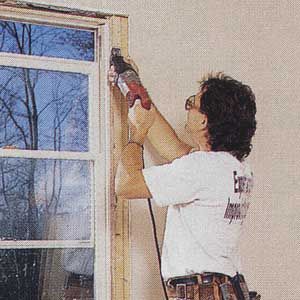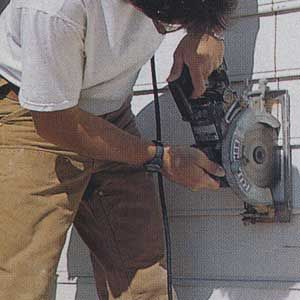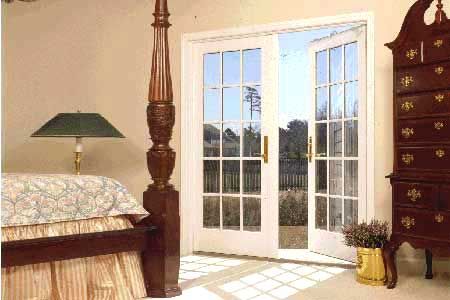You don’t have to knock down walls to make a room feel bigger. Instead, consider installing larger windows for a similar effect at a fraction of the cost. For example, French doors are a dramatic but affordable way to make a space feel brighter and more spacious while improving outdoor views.
In our guide, we’ll walk you through the opening act, or the process of selecting, installing, and maintaining French doors to transform your living space.
What Are French Doors?
French doors are double doors with multiple glass panes. They work inside and outside, allowing natural light into the home and creating a sense of openness. This increased light can make rooms feel larger and more inviting, reducing the need for artificial lighting during the daytime.
By installing French doors that open onto a patio, deck, or garden, you can also create a seamless transition between your indoor and outdoor living spaces.
Interior vs. Exterior French Doors
Interior French doors help to separate living spaces while maintaining an open feel. You can install French doors between a living room and dining room or create a home office space. Exterior French doors, on the other hand, can withstand the elements and provide access to outdoor areas like patios or decks.
Materials and Styles
French doors come in various materials, including wood, fiberglass, and vinyl-clad options. Wood offers a classic look but requires more maintenance, while vinyl-clad doors are durable and low maintenance.
Consider the Andersen Frenchwood hinged doors. These doors feature a low-maintenance vinyl-clad exterior and an unfinished pine interior that you can customize to match your decor. They also swing out of the room and don’t sacrifice interior floor space.
Preparing for French Door Installation
Before the installation begins, assess your space and gather the necessary tools and materials.
Assess Your Space
Measure the existing opening carefully to determine the appropriate door size. Standard double-wide French door units come in sizes ranging from 5 feet wide by 6 feet 8 inches tall to 6 feet wide by 8 feet tall. If you need to enlarge the opening, you may need to install a new, longer header above the door.
Gather the Necessary Tools and Materials
To install French doors, you’ll need the following tools and materials.
- Adhesive caulk
- Circular saw
- Drill and screwdriver
- Fiberglass insulation
- Level
- New casings or moldings
- Reciprocating saw with metal-cutting blade
- Screws
- Wood shims
Step-by-Step French Door Installation Guide
Installing French doors, including painting and staining, typically takes about two days. Follow our step-by-step guide to French door installation.
Remove the Existing Window

- Pry off the casings or moldings from around the inside of the window.
- Use a reciprocating saw to cut through any nails securing the window frame to the trimmer studs.
- Remove the window sash and pry the window frame out of the opening.
Prepare the Opening

- Mark the wall section below the window that needs to be removed.
- Cut through the siding and plywood sheathing with a circular saw.
- Carefully remove the severed wall section.
- If necessary, cut out the wall sole plate to ensure the bottom of the opening is flush with the interior plywood subfloor.
Install the French Door Unit
- Ensure the bottom of the opening is level and flat, using wood shims if needed.
- Apply two thick beads of adhesive caulk across the threshold.
- Lift the door unit and set it into the opening.
- Have two people hold the door assembly in place from outside while a third person secures it from inside with screws driven through the side jambs and into the trimmer studs.
- Drive screws up through the head jamb and into the header.
Adjust and Secure the Doors
- Test the doors to ensure they swing open and closed fully without binding or catching.
- Use the adjustment screws at each hinge for precise vertical and horizontal alignment.
- Install the provided brass lever handles and keyed lock cylinder.
- Install the pine stop molding along the inside of the doors, nailing it tight against the inside surfaces.
Finishing Touches and Maintenance of Your French Door
After installation, insulate and weatherproof your new French doors. Consider the finishing options to protect and beautify the doors.
Insulation and Weatherproofing
- Pack fiberglass insulation into the spaces around the door frame.
- Install new casings or moldings.
- Apply a continuous bead of adhesive caulk around the outside of the door frame to ensure a weathertight seal.
Painting and Staining Options
Regardless of the finish you choose, use an exterior-grade product that can withstand sunlight and wet weather for optimal durability. For unfinished pine interiors, you have the following finishing options:
- Paint the doors and trim for a clean, modern look.
- Apply stain and varnish to enhance the natural wood grain.
- Use a clear varnish topcoat to protect the wood while maintaining its natural appearance.
Common Challenges and Solutions With French Doors
While installing French doors can enhance your space, you may encounter some challenges. One common problem is uneven surfaces. If the opening for your French doors isn’t perfectly level or square, you may need to use shims to ensure proper installation. Take the time to level and plumb the door frame before securing it in place.
Another concern involves safety. To enhance the security of your French doors, consider installing a multipoint locking system. These systems lock the doors at multiple points along the frame, providing greater resistance to forced entry compared to traditional single-point locks.

